Clown Robin, also known as Igor Narovski, has been bringing joy and laughter to children in Latvian hospitals for over 12 years. When Russia invaded Ukraine, he also started working with Ukrainian refugees. Initially, he helped people at the Polish-Ukrainian border, then in Kyiv and other Ukrainian cities, offering support and comfort to children and their families affected by the war. A psychologist and gestalt therapist by profession, Igor is the artistic director of the Latvian hospital clown organization Dr. Klauns. Hospital clowns aim to create a sense of safety for children and preserve the joy of being a child, even in the most challenging circumstances.
The beginning of the war in Ukraine caught Narovski in February 2022 while he was in India, his favorite place to recharge and return to again and again for strength. During his stay, he followed the anxious news about the military buildup at Ukraine’s borders, which seemed like political blackmail and threats to him and many others. "It was half-past six in the morning in India. I wake up early. I was on the grounds of an ashram. Long lines formed for breakfast there. I remember standing in line when someone in front of me opened a newspaper. I peeked over their shoulder and saw three photos: Zelensky and Putin side by side, and below them, explosions in Kyiv and other Ukrainian cities. I didn’t need to know Tamil to understand the headline: ’Russia Invaded Ukraine; War Has Begun.’ At that moment, India ceased to exist for me. All the colors, all the vibrancy of India, faded and disappeared into the black cloud of war news," he says.
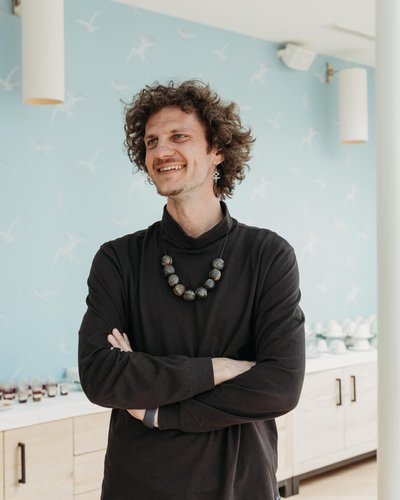
Laughter is Needed in Hospitals Too
The emotions Narovski recalls are undoubtedly familiar to many who remember those days. Like everyone else, he felt helpless and unsure of what to do or how to respond. "A few days later, I embarked on a ritual journey, a symbolic path that involves a 12-kilometer barefoot walk around a sacred mountain. I felt that I needed to do it and began walking it daily, trying to understand what to do and how to react. I knew my options were limited, but I had this inner feeling that I had to do something," he says.
Narovski was helped by his psychotherapist colleague, who asked him to work remotely with children in Ukrainian bomb shelters. That’s how it all began. "My therapist, Irena Goluba, wrote to me. She explained that a support group for Ukrainian children was being set up, where psychologists would hold sessions via Zoom for those in bomb shelters and basements. She asked if I could help and join them. I said, of course, I can. That’s how we started organizing online sessions. I realized that, despite everything, 90 minutes of clown play helped children forget where they were and what was happening around them. I saw children laughing and joining in the games," he explains.
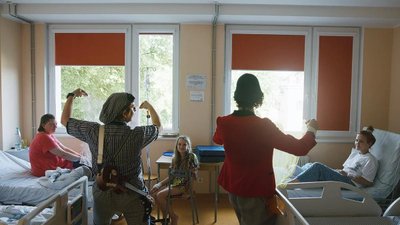
"I realized that war and its intensity paralyze a person. People cannot stay active; they don’t know what to do and feel confused. Children see their parents in this state of confusion. But through play, children regain their footing—they know what to do, how to interact with a clown. They understand the language of play, which is the most important way for them to explore the world and themselves, to make sense of what is happening and how to cope."
The Challenge of Creative Adaptation
Clowning involves active gestures and intense physical activities. How is it possible to convey this through Zoom? "It seems like Zoom takes away much of what makes clowning effective. And that’s partly true. But when there’s no other option, when I can’t go to Ukraine and I’m far away, why not try? We have communication tools and the internet. The rest is about creative adaptation: what can we do with these limitations? How can we play with them? For example, I’m sitting in front of a computer screen right now, my head visible in a small window. Suddenly, I stand up and say, ’Ouch, I hit my head!’ See? You just laughed at that. The clown interacts with the video frame as if it’s real, even though it isn’t," he explains.
According to Narovski, the seriousness and tragedy of events don’t exclude laughter. "The essence of a clown is to place themselves in the most restrictive circumstances. A hospital, for instance, is a very limited space with many rules and restrictions. It may not seem like a suitable place for a clown. And that’s precisely why the clown thinks, ’Why can’t I go there?’ The clown pushes boundaries, inserts themselves into that context, and gradually explores and expands those boundaries. For example, when we started in Latvia 12 years ago, nurses often told me that hospitals weren’t places for laughter. A terrible thing to say... Why not? Why shouldn’t people laugh in hospitals? They said it’s a place for crying, for hiding emotions because it’s a place where lives are at stake. But for me, one doesn’t exclude the other. Now, 12 years later, it’s hard to find a nurse who doesn’t laugh in hospitals or who would say something like that."

Steering Children Away from War Games
Narovski tried to rally his acquaintances, hospital clowns from Kharkiv, whom he had trained during the pandemic, to support children. But at the start of the war, this proved difficult because the war had scattered people far and wide. After returning to Riga from India, he and the Dr. Klauns team began helping refugees arriving in Latvia. They quickly realized they could provide greater support to those closer to the heart of the tragedy—in temporary shelters near the Polish border. In March 2022, they arrived in Przemyśl, Poland, and started working with refugees from Ukraine.
Narovski then decided to travel to Ukraine. Together with Scottish clown Suzie Ferguson, whom he met at a conference, and a small group of Latvian volunteers from Dr. Klauns, he first reached Lviv. There, he organized clowning activities at a regional children’s hospital, an internally displaced persons’ center, and bomb shelters. Later, he worked in Kyiv at the Ohmatdyt Hospital, which was bombed by Russians in July this year. Since February 2022, Narovski has visited Ukraine three times. "Meeting online is one thing, but I wanted to show the children that our relationship matters more than my personal safety," he says.
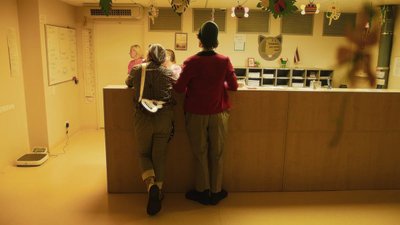
How different is the work Narovski has done in Ukraine during the war from his previous experience? "The workload in refugee centers is completely different. In a hospital, I often work with one or two children in a room or during a procedure, but in a refugee center, you need to engage 15, 20, or even 30 children at once. That requires a completely different approach to clowning—how do you keep the attention of 20 children simultaneously? How do you structure the play so that it remains a game but also has a framework? And most importantly, how do you find a place for each child in the game and give them something they can take away from it?"
Giving Children a Solid Foundation
The clown’s goal is to help children regain a sense of stability. "When I worked with internally displaced families and hospitalized children in Kyiv and Lviv, I noticed that the themes were entirely different. For instance, in Latvia, I don’t recall children in hospitals playing war games. But in Lviv and Kyiv, it’s the main theme. Children play with tanks and planes, trying to make sense of what’s happening. They dream of becoming soldiers or generals when they grow up. Their entire world revolves around the narrow theme of war. My task is to broaden that perspective. Perhaps we start with a war game, but we explore where it takes us. The goal of play isn’t just to play. Ultimately, I try to offer the child a new perspective: ’What’s next? What do you want to become? What are your dreams?’ This helps children focus on the future and realize that this war will eventually end. It won’t last forever. And when it’s over, life will continue. That knowledge helps them prepare," Narovski explains.
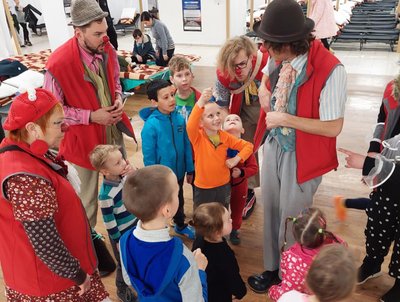
What moments and encounters have touched Narovski the most during the war in Ukraine? He says there are two. "The first was with a little girl in a refugee shelter. We clowns had come up with a song. It was simple, just four lines: ’Home is where my heart is, home is where my heart is, home is where my heart is, I’m with you in my heart.’ As we were walking around the shelter, a very gentle child’s voice suddenly said from under a pile of blankets, ’I can sing too!’ The blankets began to move, and out came a little five-year-old girl—tiny, beautiful, like she was from another world. And she began to sing that song with us," Narovski recalls.
"A child who had lost her home understood that the real home—the one in her heart—could never be taken away. She sang, and her mother stood nearby, watching. The mother saw her little girl singing in another country, during wartime. Suddenly, the mother grabbed the girl in her arms. We clowns surrounded them, hugging them. The mother began to cry, kissing her daughter and trembling all over. I felt an incredible warmth in that circle—six clowns, a mother in tears, and a little girl in a pink jacket with hearts. For a moment, everything felt okay. Those tears were important, as was the fact that the girl was in her mother’s arms. Before that, they hadn’t had emotional contact. The mother had been trying to be strong for her child, keeping emotional distance. But now, she allowed herself to say, ’You know, this hurts me deeply too, and it’s very painful.’ She cried but also hugged her daughter and said, ’We’ll get through this!’ That moment was very important to me."
The Power of Presence
The second moment that profoundly touched Narovski wasn’t with a child. "I had a conversation with an older woman at a refugee center in Przemyśl, Poland. She was sitting in a wheelchair, resting her head against a metal handrail. We started talking, even though clowns usually don’t talk—their work is primarily nonverbal. But this time, words seemed necessary. She spoke haltingly, saying how angry she was about everything that was happening. She called the Russian soldiers beasts and non-humans. Then suddenly, she started doubting herself: ’Do I even have the right to say that?’ I told her, ’Yes, you absolutely have the right to say what you feel. What’s happening to you gives you that right.’"

As the conversation continued, the woman shared that she had lost her ability to walk due to the psychological trauma caused by Russian airstrikes. "She told me about walks along the Kharkiv river with her grandchild. When I mentioned that I had also visited Kharkiv, she was surprised. She jumped from topic to topic—talking about the books she left behind, the windows shattered by explosions, and how she feels like the ground disappears from under her feet. Then, quite unexpectedly, she said, ’Your colleagues are already leaving; you should go to cheer up others.’ I replied, ’Others can wait. I want to spend a little more time with you.’ She then said, ’You know, I feel good right now. For the first time since the war started.’ We just looked at each other. At that moment, it felt like the war didn’t exist anymore. It was just a person in front of me, and me in front of them. And everything was okay. That moment taught me how crucial presence is in our lives. It should never be underestimated."
Not Suppressing Any Emotions
How does Narovski cope with being surrounded by children’s suffering for the past 12 years? "I don’t take anything from the hospital home with me. Nothing stays with me because I don’t suppress any emotions. When I’m in the hospital, I don’t resist anything I feel. If I fight emotions, a conflict arises, and the emotions get stuck in my psyche. They linger and can stay for years. But if you don’t resist them, they disappear within a few minutes. The nature of emotions is to arise in a specific moment, in a specific situation, with a specific person," he says.
According to Narovski, the only way not to harm yourself is to let emotions pass. "When I encounter emotions in the hospital, I act them out immediately—exaggeratedly, humorously, lightly, and with enjoyment. It doesn’t matter what emotion it is: pain, fear, horror, disgust, or joy. It doesn’t matter—a clown is an emotional being. His primary means of communication is emotions. He is so transparent that everyone understands what he feels. And that’s funny. It creates a feeling of ’I see you, and I affect you.’ Children immediately sense that what they do elicits emotions in the clown, and they realize it has meaning."

This is why you must not hide your emotions. "If I hid them, the child wouldn’t feel this connection. They wouldn’t understand if they’re being seen and heard. That’s why I don’t have anything to take home with me. Besides, all those moments are wonderful! I’m always surprised—like, I’ve written several books, and another one, The Smiling Red, will be published soon. People say these books have moved them, made them cry. But for me, they’re funny! I feel like I understand my books the least. I write them thinking they’re full of humor, lightness, and joy. But they affect people in a completely different way. Maybe that’s the clown’s perspective—seeing everything a bit differently. If I weren’t a clown, I’d probably react to the same stories entirely differently," he concludes.
The Power of "No"
Does it often happen that a child refuses to let a hospital clown approach them? After all, psychologists often encounter such situations. "Yes, it can happen, but it’s extremely rare. It’s a rare case, but even a clown can be told, ’You know, now is not the right time. There’s no time for play; I don’t want to see you.’ That, too, has power. There’s a lot of strength in the word ’no’—it’s about boundaries, what I want and what I don’t want. Because in the hospital, no one asks you what you want or are ready for. Things just happen, and you don’t feel like you have any control. Saying ’no’ to someone, even to a clown, gives you a sense of control. You can assert yourself. And that’s important too," he emphasizes.
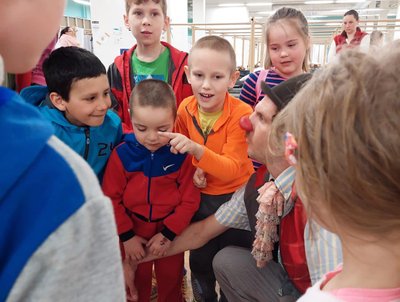
Sustained Efforts for the Future
What are Narovski’s and his colleagues’ plans for the future? "You’re asking about plans related to Ukraine. For me, it’s essential to have a systematic approach to the concept and idea of doctor clowns. It’s not a one-off charity event, like visiting a hospital at Christmas to hand out gifts. We don’t give anything away or create celebratory moments—we’re part of the everyday," he explains.
"We are present in hospitals every day. The same applies to Ukraine. For me, it’s important that the work is consistent and systematic. Often, when war begins, people experience an explosion of emotions and great compassion. But a year later, that fades, even though the war continues. Now, over a thousand days have passed since the war started. Those who received support in the beginning often lose it later—precisely when the situation becomes harder. In the first months, people are shielded by a state of shock, but when the shock fades, they face the reality that has become their daily life. So, there’s nothing new or extraordinary planned—just continuing what we’re doing. Consistency and presence are key because that’s what creates long-term impact," says Narovski.
